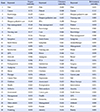Abstract
Purpose
This study examined the suitability of using text network analysis (TNA) methodology for topic analysis of academic papers related to nursing.
Methods
TNA background theories, software programs, and research processes have been described in this paper. Additionally, the research methodology that applied TNA to the topic analysis of the academic nursing papers was analyzed.
Results
As background theories for the study, we explained information theory, word co-occurrence analysis, graph theory, network theory, and social network analysis. The TNA procedure was described as follows: 1) collection of academic articles, 2) text extraction, 3) preprocessing, 4) generation of word co-occurrence matrices, 5) social network analysis, and 6) interpretation and discussion.
Conclusion
TNA using author-keywords has several advantages. It can utilize recognized terms such as MeSH headings or terms chosen by professionals, and it saves time and effort. Additionally, the study emphasizes the necessity of developing a sophisticated research design that explores nursing research trends in a multidimensional method by applying TNA methodology.
References
1. Roberts CW, Popping R. Themes, syntax and other necessary steps in the network analysis of texts: a research paper. Soc Sci Info. 1996; 12. 35(4):657–665. DOI: 10.1177/053901896035004005.

2. Zhang L, Hall M, Bastola D. Utilizing twitter data for analysis of chemotherapy. Int J Med Inform. 2018; 12. 120:92–100. DOI: 10.1016/j.ijmedinf.2018.10.002.

3. Park EJ, Kim YJ, Park CS. A comparison of hospice care research topics between Korea and other countries using text network analysis. J Korean Acad Nurs. 2017; 10. 47(5):600–612. DOI: 10.4040/jkan.2017.47.5.600.

4. Zavarrone E, Grassia MG. Text analysis: an overview. Wiley StatsRef. 2018; DOI: 10.1002/9781118445112.stat08089.

5. Paranyushkin D. [Internet]. Identifying the pathways for meaning circulation using text network analysis. Berlin: Nodus Labs;c2011. up-dated 2011 Dec 25. cited 2019 Jan 20. Available from: http://noduslabs.com/research/pathways-meaning-circulation-text-network-analysis.
6. Park CS, Jung JW. Text network analysis: detecting shared meaning through socio-cognitive networks of policy stakeholders. J Gov Studies. 2013; 08. 23. 19(2):73–108.
7. Park EJ, Cho SZ. KoNLPy: Korean natural language processing in python. In : Proceedings of the 26th Annual Conference on Human & Cognitive Language Technology; 2014 Oct 10-11; Chuncheon. Kangwon National University;2014. 10. p. 133–136.
8. He Q. Knowledge discovery through co-word analysis. Libr Trends. 1999; Summer. 48(1):133–159.
9. Wasserman S, Faust K. Social network analysis: methods and applications. New York: Cambridge University Press;1994. p. 825.
10. Baldwin C, Hughes J, Hope T, Jacoby R, Ziebland S. Ethics and dementia: mapping the literature by bibliometric analysis. Int J Geriatr Psychiatry. 2003; 18(1):41–54. DOI: 10.1002/gps.770.

11. Scott SD, Profetto-McGrath J, Estabrooks CA, Winther C, Wallin L, Lavis JN. Mapping the knowledge utilization field in nursing from 1945 to 2004: a bibliometric analysis. Worldviews Evid Based Nurs. 2010; 7(4):226–237. DOI: 10.1111/j.1741-6787.2010.00197.x.

12. Lee SK, Jeong S, Kim HG, Yom YH. A social network analysis of research topics in Korean nursing science. J Korean Acad Nurs. 2011; 10. 41(5):623–632. DOI: 10.4040/jkan.2011.41.5.623.

13. Kim MJ, Noh SM, Ryu EJ, Shin SM. Research trend analysis of do-not-resuscitate decision: based on text network analysis. Asian Oncol Nurs. 2014; 12. 14(4):254–264. DOI: 10.5388/aon.2014.14.4.254.

14. Kwon SY, Park EJ. Knowledge structure of the Korean journal of occupational health nursing through network analysis. Korean J Occup Health Nurs. 2015; 05. 24(2):76–85. DOI: 10.5807/kjohn.2015.24.2.76.

15. Kwon SY, Bae KR. A study on the knowledge structure of cancer survivors based on social network analysis. J Korean Acad Nurs. 2016; 02. 46(1):50–58. DOI: 10.4040/jkan.2016.46.1.50.

16. Kim YJ, Jang SN. Mapping the knowledge structure of frailty in journal articles by text network analysis. PloS one. 2018; 04. 13(4):e0196104. DOI: 10.1371/journal.pone.0196104.

18. Park YS. Formation of nursing knowledge: inductive reasoning. Perspect Nurs Sci. 2004; 12. 1(1):36–49.
19. Lee SW. Prospects for nursing theory analysis, evaluation and development. Perspect Nurs Sci. 2004; 12. 1(1):1–21.
20. Lee SS. A content analysis of journal articles using the language network analysis methods. J Korean Soc Inf Manage. 2014; 12. 31(4):49–68. DOI: 10.3743/KOSIM.2014.31.4.049.

21. Zhang Y, Chen H, Lu J, Zhang G. Detecting and predicting the topic change of Knowledge-based systems: a topic-based bibliometric analysis from 1991 to 2016. Knowl Based Syst. 2017; 07. 133:255–268. DOI: 10.1016/j.knosys.2017.07.011.

22. Montemurro MA, Zanette DH. Keywords and co-occurrence patterns in the Voynich manuscript: an information-theoretic analysis. PLoS One. 2013; 06. 8(6):e66344. DOI: 10.1371/journal.pone.0066344.

23. Lee SS. Network analysis methods. Seoul: Nonhyeong;2012. p. 370.
24. Borgatti SP, Halgin DS. On network theory. Organ Sci. 2011; 09. 22(5):1168–1181. DOI: 10.1287/orsc.1100.0641.

25. Park HW, Leydesdorff L. Understanding the KrKwic: a computer program for the analysis of Korean text. J Korean Data Anal Soc. 2004; 10. 6(5):1377–1387.
26. Lee TW, Park KO, Seomun GA, Kim MY, Hwang JI, Yu SY, et al. Analysis of research articles published in the Journal of Korean Academy of Nursing Administration for 3 years (2013~2015): the application of text network analysis. J Korean Acad Nurs Adm. 2017; 01. 23(1):101–110. DOI: 10.11111/jkana.2017.23.1.101.

27. Kim SY, Park JE, Seo HJ, Lee YJ, Jang BH, Son HJ, et al. NECA's guidance for undertaking systematic reviews and meta-analyses for intervention. Seoul: National Evidence-based Healthcare Collaborating Agency;2011. p. 288.
28. Zheng P, Liang X, Huang G, Liu X. Mapping the field of communication technology research in Asia: content analysis and text mining of SSCI journal articles 1995-2014. Asian J Commun. 2016; 10. 26(6):511–531. DOI: 10.1080/01292986.2016.1231210.

29. Persson O, Danell R, Schneider JW. How to use Bibexcel for various types of bibliometric analysis. In : Åström F, Danell R, Larsen B, Schneider JW, editors. ISSI Newsl [Internet]. 2009. 06. 05-S:p. 9–24. cited 2019 Jan 20. Available from: http://issi-society.org/media/1053/ollepersson60.pdf.
30. Park EJ, Ahn DW, Park CS. Text network analysis of newspaper articles on life-sustaining treatments. J Korean Acad Community Health Nurs. 2018; 06. 29(2):244–256. DOI: 10.12799/jkachn.2018.29.2.244.





 PDF
PDF ePub
ePub Citation
Citation Print
Print








 XML Download
XML Download